Trickling Filter Ecology...
Let's start with a figure that shows improper operation of a trickling filter. The black shapes represent rocks that are
of fairly even size. The colored shades are for the feed water applied to the trickling filter. Note that the second
application arrived before the first had drained from the rocks. There was a barrier to entry of air. The fluids are
shown in different colors because the upper has some dissolved oxygen. Microbial activity has depleted the DO in the lower
portion, and anaerobic metabolism is so slow as to be negligible in this short time period even if there are some organisms
present in the slime on the rocks that can metabolize at low oxidation / reduction potentials.
 "Improper Operation of a Trickling Filter"...
"Improper Operation of a Trickling Filter"...
A very interesting experiment that is often included in courses about environmental microbiology has students collect rocks
at different depths of a trickling filter. The films on the rocks are examined to determine film thicknesses, identify
organisms, and to estimate their metabolic rates. Understanding the data is greatly complicated by the many interdependencies.
The following figure is typical of what might be expected when the rate of the arms that distribute the waste water is varied.
 "Relationship Between Film Thickness & Dosing"...
"Relationship Between Film Thickness & Dosing"...
It appears that splashing waste water on the rocks every minute is ok; every 3 minutes is about the same. When the interval
is too long, e.g., 30 minutes, the film is undernourished and relatively thin. The next figure shows changes throughout the
year. There would need to be much more data for statistical validity. While speculation about the graphs would be a good
discussion in class, the main messages are that seasonal temperature must be quite important in terms of film thickness and
that thickness can vary greatly with depth.
 "Relationship Between Film Thickness & Season"...
"Relationship Between Film Thickness & Season"...
Organisms found in a trickling filter ; (1) flies, (2) insects and worms, (3) succession of communities, (4) rotifers and
nematodes, (5) holozoic protozoa different levels, (6) bacteria, fungi and protozoa, (7) nuisance flies, (8) dead organic
solids. Upper layers may be inhibited or killed while lower layers survive. While both activated sludge and trickling
filters have abundant organisms entering, the process conditions tend not to favor them; these organisms either die out
or contribute little to the treatment process and are ignored in most analyses. Some do hang on at low level, and a few
may thrive.
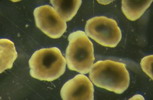
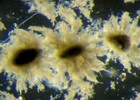
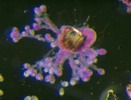
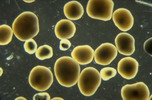
In activated sludge ; (1) slime formers and filamentous organisms intermixed, (2) Zooglea ramigera - gram - , non
sporulating, motile, capsulated rods (3) some organisms dead or cannot reproduce, (4) if homogenizer used, counts rise 10
to 100 x, 2.2 x 106 / mL (5) filamentous organisms usually predominant in bulking sludge, (6) Sphaerotilus
natans - over 14 strains found, (7) fungi uncommon, often have protozoa - good indicators, (8) rotifers and nematodes
can be significant but often absent, (9) phage seldom noted, too much trouble to look, (10) how come diversity is
maintained ? Population dynamics + parisitism or predation control (11) prey can hide from predator in slime, (12) very few algae because no light, (13) floc properties depend on feed - pentoses = dense floc while hexoses = filamentous floc, (14) inadequate aeration = Sphaerotilus but some disagreement, (15) microbes are between "declining growth" + endogenous phase, (16) fungi may dominate for industrial wastes - low O2 because of high BOD5, (17) low N favors fungi, need less/unit mass, (18) predatory fungus Zoophagus insidiens eats rotifers + lets their prey, bacteria, grow, get
poorer nitrification.
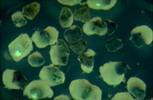
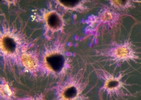
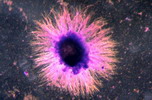
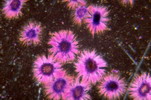
Trickling filters (bacteria beds in UK) ; (1) very diverse, shifts to suit waste, (2) do not operate as close to starvation
conditions as in act sludge, more fungi, (3) surface layers have changing predominance with season, (4) algae of secondary
importance metabolically but luxuriant growth may clog system, (5) protozoa very abundant, very different in different
strata.
(1) Psychoda flies a nuisance but larvae active in metabolism of wastes, (2) filter is warmer than surroundings, thus
active all year, (3) high BOD has fewer species, maybe less O2, (4) toxic wastes have fewer species, resistant
flies can be very numerous, (5) size of support medium can direct species, also surface properties, (6) film properties and
presence of a given species are a mutual interaction, i.e., thick film may be unsuitable but organism may produce a thin
film, (7) species distribution varies greatly with depth, (8) at extreme, no active algae in lower depths, (9) dosing,
nozzle design, geometry also affect species selection.


 "Improper Operation of a Trickling Filter"...
"Improper Operation of a Trickling Filter"...
 "Improper Operation of a Trickling Filter"...
"Improper Operation of a Trickling Filter"...
 "Relationship Between Film Thickness & Dosing"...
"Relationship Between Film Thickness & Dosing"...
 "Relationship Between Film Thickness & Season"...
"Relationship Between Film Thickness & Season"...









